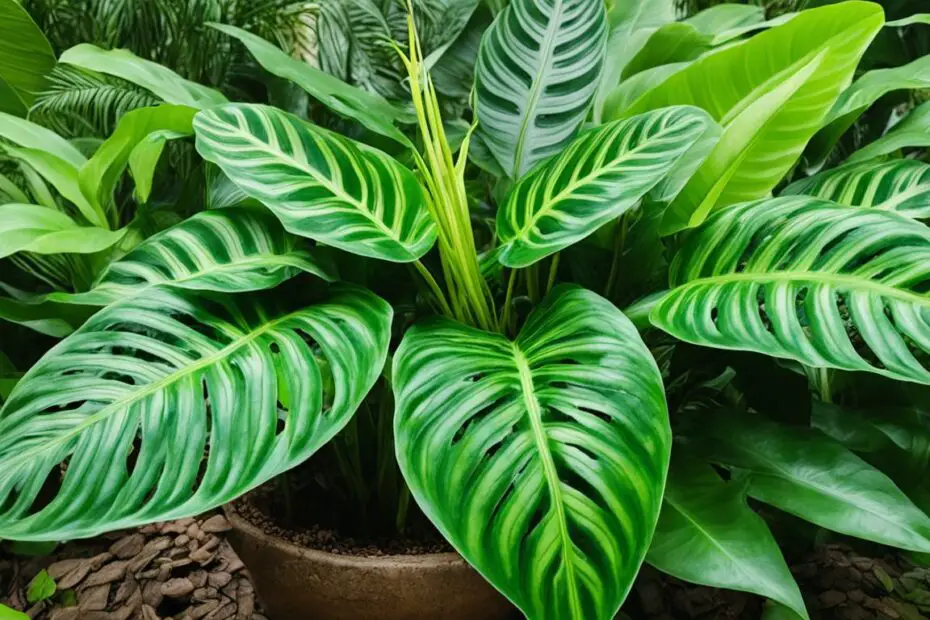Prayer plants, also known as Calatheas, are tropical houseplants that have captured the hearts of plant enthusiasts worldwide. Their fascinating history and captivating characteristics make them a popular choice for indoor greenery.
Native to Brazil, these plants belong to a genus that includes various species with unique leaf patterns. The name “prayer plant” originated from the way some Calathea species move their leaves, folding them up at night like praying hands and unfurling them during the day. This graceful movement adds an element of wonder and spirituality to these already stunning plants.
The leaves of prayer plants are adorned with colorful geometric patterns, resembling an artist’s masterpiece. These patterns, along with their ability to adjust their leaf movements, make them an eye-catching addition to any home or office.
Key Takeaways:
- Prayer plants, also known as Calatheas, are tropical houseplants prized for their sensational foliage.
- Their name came from the way some species of Calathea fold their leaves like praying hands.
- These plants have colorful geometric patterns on their leaves, resembling artwork.
- Prayer plants are native to Brazil and thrive in bright but indirect light.
- Their leaf movements and striking appearance bring a sense of wonder and spirituality to any space.
The Origins of Prayer Plants
Prayer plants, also known as Calatheas, have a rich history rooted in their origins. These tropical houseplants originate from the lush landscapes of Brazil, where they thrive in the dappled shade provided by tall trees in tropical forests. The vibrant colors and intricate patterns of their leaves are a testament to their native habitat’s diverse ecosystem.
As they made their way into households around the world, prayer plants adapted to a different environment. They found their niche in bright but indirect light, making them suitable for various indoor spaces. However, it’s important to note that prayer plants are sensitive to direct bright light, which can harm their leaves and disrupt their distinctive patterns.
When growing prayer plants, it’s essential to recreate their preferred growing conditions. These plants thrive in moist soil, but it’s important not to overwater them, as overly saturated soil can lead to root rot. A pot with good drainage holes and a well-draining potting compost that retains moisture is ideal for their growth and development.
Beyond light and soil, prayer plants also require high humidity to flourish. Mimicking their natural tropical habitat, creating a humid environment can be achieved by misting the leaves regularly or placing the plants on a tray filled with water and pebbles to increase humidity levels.
“The prayer plant’s origins in Brazil have shaped its unique characteristics, making it a stunning addition to any indoor space.”
| Origins | Light | Soil | Humidity |
|---|---|---|---|
| Brazil | Bright but indirect light | Moist but well-draining | High humidity |
The Evolution of Prayer Plants
The evolution of prayer plants has led to the development of various species within the Calathea genus. Each species exhibits unique characteristics and leaf patterns, making them a captivating choice for indoor gardening enthusiasts.
Over time, these plants have adapted to their natural environment and have become popular as houseplants due to their striking foliage. Let’s explore the evolution of prayer plants and the diverse species that have emerged.
Prayer Plant Species
Within the Calathea genus, numerous species have evolved, each with its own distinct features. Here are some examples:
| Species | Characteristics | Leaf Pattern |
|---|---|---|
| Calathea roseopicta | Known for its elegantly shaped leaves and vibrant colors. |
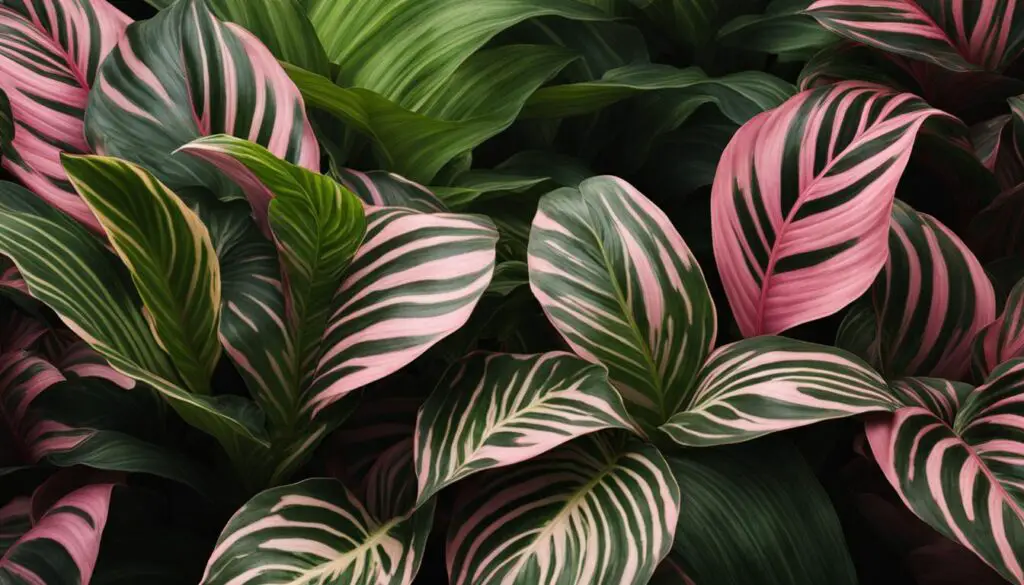
|
| Calathea orbifolia | Recognized for its oversized, round leaves and contrasting patterns. |
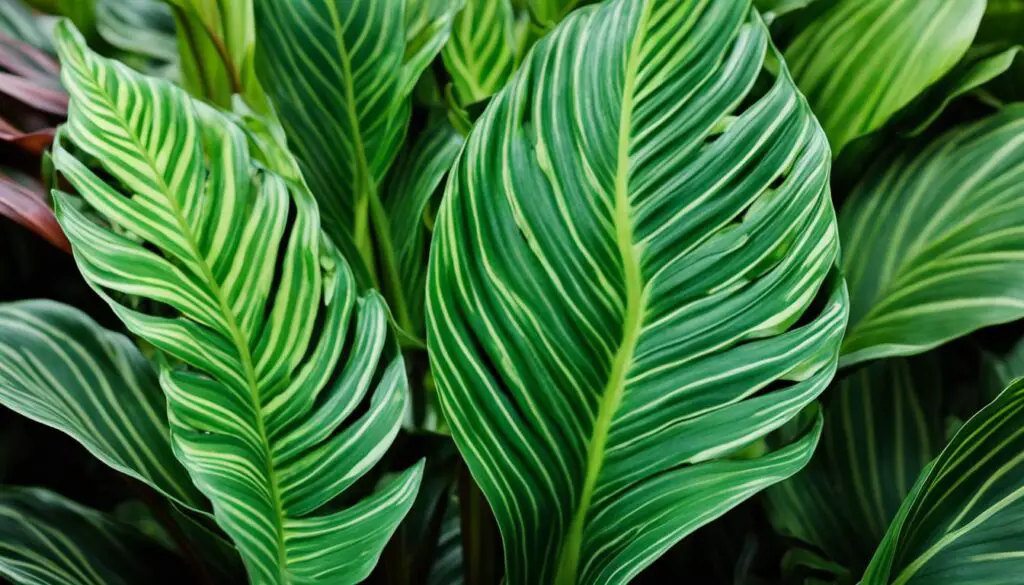
|
| Calathea lancifolia | Notable for its long, lance-shaped leaves and distinctive feather-like patterns. |
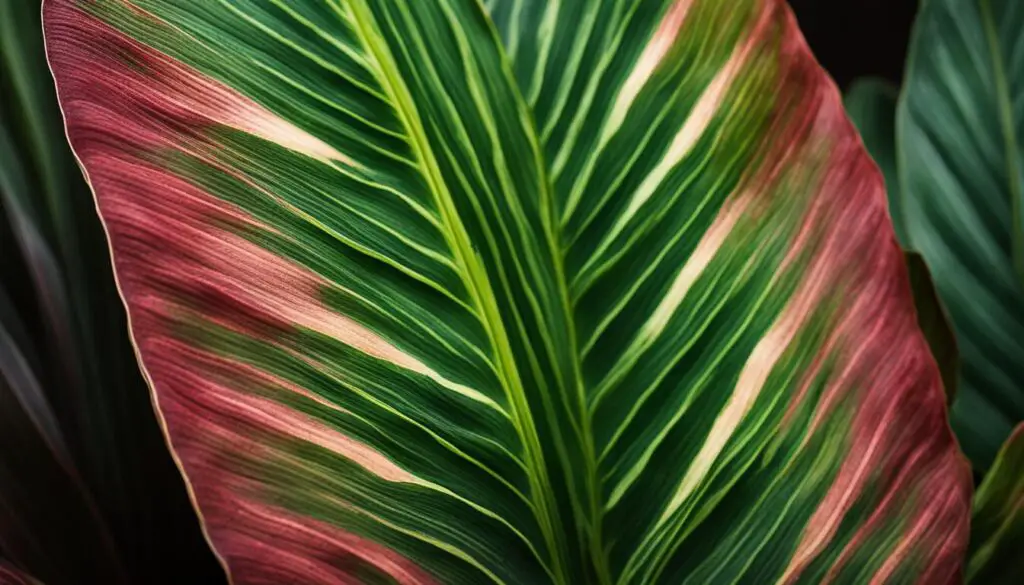
|
Through evolution, each species has honed its own unique characteristics, captivating plant enthusiasts with their mesmerizing leaf patterns.
The fascinating evolution of prayer plants has resulted in a variety of species, each offering a different visual and aesthetic experience. As these plants have adapted to various environmental conditions, they have thrived as stunning houseplants, bringing joy and beauty to homes across the world.
Notable Characteristics of Prayer Plants
Prayer plants, also known as Calatheas, possess unique characteristics that make them captivating additions to any indoor space. They are not only visually appealing but also exhibit fascinating behaviors that set them apart from other houseplants.
One of the most striking characteristics of prayer plants is their distinctive leaf movements. Some species have leaves that fold up at night, resembling folded hands in prayer, and unfold during the day, creating a dynamic display. This natural movement adds a touch of wonder and intrigue to these plants, making them a delight to observe.
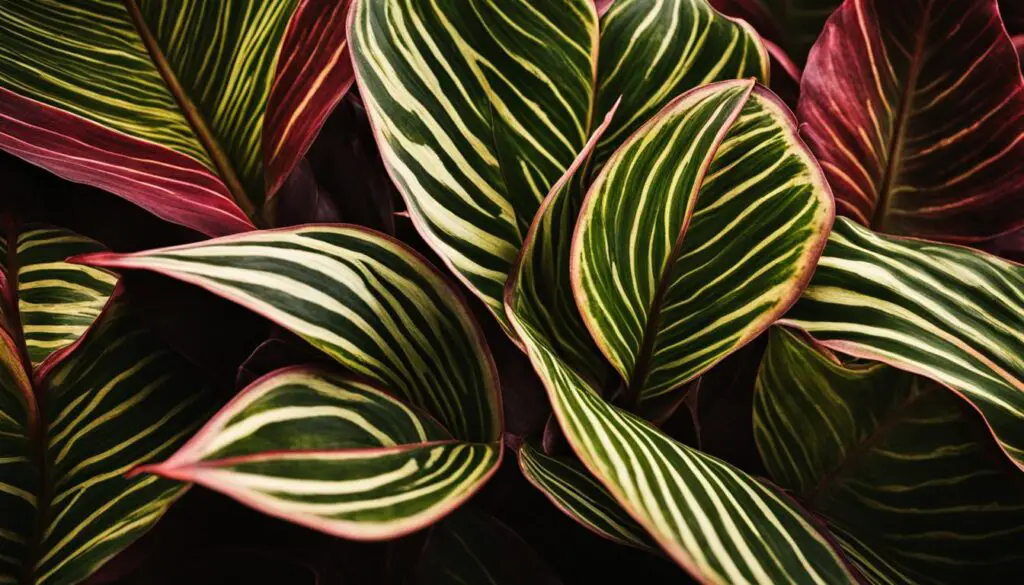
Another notable characteristic of prayer plants is the colorful geometric patterns found on their leaves. These intricate designs resemble artistic paintings, adding a vibrant and eye-catching element to their overall appearance. With their bold colors and striking patterns, prayer plants can instantly elevate the aesthetics of any room.
Prayer plants thrive in high humidity environments, making them an ideal choice for bathrooms or kitchens. They enjoy a moist but not waterlogged soil, ensuring that their roots have adequate moisture without the risk of rot. Temperature-wise, prayer plants prefer a range between 18-30°C (65-86°F), making them well-suited for indoor climate conditions.
To ensure the optimal growth and health of prayer plants, it is important to keep them away from cold drafts. These plants are sensitive to temperature fluctuations, and exposure to chilly air can cause stress and damage to their foliage.
Overall, the notable characteristics of prayer plants, including their leaf movements, captivating leaf patterns, preference for high humidity, and temperature sensitivity, make them stunning and intriguing additions to any plant collection.
Caring for Prayer Plants
Proper care is essential for ensuring the health and vitality of your prayer plants, also known as Calatheas. By following these guidelines, you’ll be able to create an optimal environment for your plants to thrive.
Watering
Prayer plants require regular watering to keep the soil moist. However, it’s important to avoid allowing them to sit in water for extended periods, as this can lead to root rot. Instead, water your plants thoroughly and allow the excess water to drain out completely.
Fertilizing
Your prayer plants can benefit from monthly feeding with a diluted liquid houseplant fertilizer during the spring and autumn months. This will provide them with the necessary nutrients to support healthy growth and vibrant foliage.
Pruning
While prayer plants do not require extensive pruning, it’s important to remove any dead or dying leaves. This will not only improve the aesthetic appeal of your plants but also prevent the spread of diseases.
Resilience and Stress
Prayer plants are remarkably resilient and can bounce back from stress-induced leaf loss. If you notice signs of stress, such as yellowing or wilting leaves, examine the environmental conditions to ensure they are suitable for your plants. Making adjustments to light, humidity, and temperature levels can help restore their health and vitality.

By employing proper care techniques, you can ensure that your prayer plants thrive and continue to mesmerize with their captivating foliage.
Common Problems with Prayer Plants
While prayer plants are generally easy to care for, they can encounter a few common problems. Understanding these issues and knowing how to address them will help you keep your prayer plants thriving. The most common problems with prayer plants are related to watering.
Inadequate Watering
One of the main prayer plant problems is under-watering. When the soil becomes too dry, the plant may start to show signs of distress. Wilting leaves, curling leaves, and brown edges are common symptoms. To remedy this, ensure that you water your prayer plant thoroughly, allowing the water to reach the roots, but avoid overwatering.
“Proper watering is essential for the health of prayer plants. Finding the right balance of moisture is key.”
Excessive Watering
On the other hand, over-watering can also lead to issues with prayer plants. When the soil remains overly saturated for extended periods, it can cause the roots to rot, resulting in yellowing leaves and rotting stems. It’s important to observe the plant’s response and adjust your watering routine accordingly.
Providing the Right Amount of Moisture
Prayer plants thrive when the moisture level in the soil is properly balanced. To achieve this, water your prayer plant when the top inch of soil feels dry. Ensure that the pot has drainage holes to prevent water from accumulating at the roots. You can also place the pot on a tray with pebbles and water to increase humidity around the plant.
| Problem | Symptoms | Solution |
|---|---|---|
| Under-watering | Wilting, curling leaves, brown edges | Thoroughly water the plant, ensuring water reaches the roots |
| Over-watering | Yellowing leaves, rotting stems | Observe the plant’s response and adjust watering routine accordingly |
By addressing common watering issues and providing the proper care, you can ensure that your prayer plants remain healthy and vibrant.
The Spiritual Significance of Prayer Plants
Prayer plants, also known as Calatheas, hold a special place in the hearts of many due to their spiritual allure. The name “prayer plant” itself evokes a sense of mystery and wonder, drawing connections to the act of prayer. Just like the movements of some Calathea species that close their leaves at night and open them during the day, prayer is a practice that involves spending quality time with God.
Observing the beauty and intricacy of prayer plants can ignite a sense of connection to the divine. The colorful geometric patterns on their leaves serve as a gentle reminder of the invitation to spend time with God, to enter into a space of peace and reflection.
“The beauty and elegance of prayer plants inspire a sense of wonder and awe, opening our hearts to the presence and love of God.” – [Author Name]
For many, the spiritual meaning of prayer plants lies in their ability to evoke a sense of calm and reverence. These plants serve as gentle reminders of the love that God has for us and the sacredness of prayer. Just as the leaves of prayer plants move in graceful harmony, so too can our hearts and spirits be in tune with the divine.
Embracing the spiritual significance of prayer plants can deepen our prayer practices and enhance our spiritual journeys. Whether we find inspiration in their movements, appreciate their vibrant foliage, or use them as focal points for prayer and meditation, these plants serve as conduits for spiritual growth and connection.
Creating Sacred Spaces with Prayer Plants
The presence of prayer plants in our homes can transform ordinary spaces into sanctuaries of peace and tranquility. The soft rustling of their leaves can create a calming atmosphere, encouraging us to slow down, to enter into a time of stillness and introspection. As we care for these plants, watering them, tending to their needs, we are reminded of the care and attention God gives us.
By intentionally placing prayer plants in areas of our homes where we pray or meditate, we invite their spiritual energy to enhance our practices. Whether it is a personal altar, a quiet corner, or a sacred space dedicated to prayer, the presence of prayer plants can heighten our awareness of the divine presence and deepen our connection to the spiritual realm.
Nurturing the Spirituality of Prayer Plants
To fully embrace the spiritual significance of prayer plants, it is essential to care for them with intention and mindfulness. Just as we nurture our spiritual lives, tending to our faith, prayer plants need proper attention to thrive.
- Place your prayer plants in bright but indirect light to maintain their vibrant colors.
- Keep the surrounding environment warm and humid, mimicking their natural tropical habitat.
- Water them regularly, allowing the soil to stay moist but not waterlogged.
- Prune any dead or yellowing leaves with care, symbolizing the shedding of what no longer serves us.
By caring for prayer plants with love and mindfulness, we not only foster their growth but also deepen our connection to the spiritual meaning they embody.
The spiritual significance of prayer plants invites us to pause, reflect, and engage in a practice of prayer that connects us to something greater than ourselves. These unique houseplants serve as powerful reminders of the beauty and wonder inherent in the act of prayer, guiding us on a journey of spiritual growth and deepening our connection to the divine.
The Wonder of Prayer
Prayer is a wonder, a sacred practice that enables us to connect with the divine and experience the awe-inspiring presence of God. It is a profound journey of the heart, a time set aside to communicate with our Creator and find solace in His everlasting love.
While prayer may sometimes be accompanied by rituals and expectations, its true essence lies in the simplicity of saying “yes” to the invitation to be with God. It is a heartfelt conversation, an opportunity to pour out our hopes, fears, and dreams, knowing that God hears and deeply cares for us.
Prayer is most powerful when we approach it with authenticity, free from the need to perform or impress. It is a space where we can fully be ourselves, knowing that we are accepted and loved unconditionally by our Heavenly Father. In prayer, we can surrender our burdens, find peace in the midst of chaos, and experience the transformative power of God’s grace.
Just as the prayer plant unfolds its leaves, revealing its beauty to the world, prayer opens our hearts, allowing us to experience the wonder of God’s presence and guidance. It is a sacred connection that transcends the boundaries of time and space, bringing us closer to the divine and fostering a deep sense of awe and reverence.
“Prayer is not asking. It is a longing of the soul. It is daily admission of one’s weakness. It is better in prayer to have a heart without words than words without a heart.” – Mahatma Gandhi
Through prayer, we enter into a divine conversation that transcends human understanding. It is an invitation to seek God’s wisdom, guidance, and comfort, knowing that He hears our every plea. In prayer, we find solace, hope, and renewed strength, even in the face of life’s challenges.
So, let us embrace the wonder of prayer and allow it to deepen our relationship with God. Let us approach prayer with humility and trust, knowing that our Heavenly Father delights in hearing our every word. In prayer, we find connection, renewal, and a profound sense of purpose.
Experience the Wonder:
- Schedule regular times for prayer to make it a consistent part of your daily life.
- Create a sacred space where you can retreat and engage in prayer without distractions.
- Keep a prayer journal to record your thoughts, reflections, and prayer requests.
- Explore different forms of prayer, such as silent contemplation, gratitude prayers, or intercessory prayers.
- Seek spiritual guidance or join a prayer community to deepen your prayer practice and learn from others.
Embrace the wonder of prayer as a transformative and life-giving practice. It is a divine invitation to experience the depth of God’s love, find solace in His presence, and discover the abundant grace that surrounds us.
The Three W’s of Wonder
Wonder is an extraordinary feeling that brings a sense of awe and amazement. It prompts us to say “wow” and connects us to the divine. It often comes from witnessing beauty or experiencing goodness in the world around us. When we encounter something truly remarkable, it sparks a deep appreciation and fills us with wonder.
Another aspect of wonder is found in the act of questioning “why.” When we wonder in perplexity, we invite a deeper understanding and seek answers to life’s mysteries. This type of wonder allows us to bring our questions, pain, and confusion to God. It opens up a space for reflection and contemplation, encouraging us to delve deeper into our faith journey.
Lastly, the question “what if” ignites our imagination and propels us to envision a future filled with hope and possibilities. Through prayer, we can explore the what-ifs, allowing our minds to wander and dream. What if our prayers were answered? What if our dreams became reality? What if we stepped into the fullness of who we were created to be? The question “what if” stirs our hearts and inspires us to dream big with God.
Conclusion
Prayer plants, also known as Calatheas, have a rich history and unique characteristics that make them fascinating houseplants. These plants originate from tropical regions, particularly Brazil, and have evolved into various species with distinct leaf patterns. The name “prayer plant” stems from the way some Calathea species move their leaves, resembling praying hands. Prayer plants not only add beauty to our homes with their colorful and intricate foliage, but they also carry a spiritual significance that connects us to the divine.
Caring for prayer plants requires creating the right environment. These plants thrive in bright but indirect light and prefer moist soil, without being waterlogged. Additionally, high humidity and a warm temperature are essential for their well-being. By providing these optimal conditions, we can ensure the health and vibrancy of our prayer plants.
Prayer plants serve as reminders of the wonder of prayer and the invitation to spend time with God. Just as these plants move their leaves in a rhythmic pattern, prayer invites us to connect with the divine, marvel at the beauty of creation, and express our questions, pains, and hopes. By cultivating a prayerful mindset and tending to our prayer plants, we can experience the joy and peace that comes from nurturing our spiritual lives.
FAQ
What is the history of prayer plants?
Prayer plants, also known as Calatheas, have a rich history as tropical houseplants. They primarily come from Brazil and have been prized for their sensational foliage for many years.
Where do prayer plants originate from?
Prayer plants are native to the tropics, particularly in Brazil. They are found growing in the dappled shade provided by tall trees in tropical forests.
How have prayer plants evolved over time?
The evolution of prayer plants has resulted in the development of various species within the Calathea genus. Each species has unique characteristics and leaf patterns that have adapted to their natural environment.
What are some notable characteristics of prayer plants?
Prayer plants are known for their distinctive leaf movements, colorful geometric patterns, and striking foliage. They enjoy high humidity, prefer moist but not waterlogged soil, and can tolerate temperatures between 18-30°C (65-86°F).
How should I care for prayer plants?
Prayer plants thrive in bright but indirect light, prefer moist soil, and require high humidity. They should be watered regularly to keep the soil moist but not overly saturated. Using a pot with good drainage holes and a potting compost that retains moisture is ideal. They also benefit from monthly feeding with a diluted liquid houseplant fertilizer during the spring and autumn months.
What are common problems with prayer plants?
The most common problems with prayer plants are related to watering. Under-watering can cause wilting and browning leaf edges, while over-watering can lead to yellowing leaves and rotting stems. Finding the right balance of moisture is key to their health.
What is the spiritual significance of prayer plants?
Prayer plants have a spiritual allure due to their name and the way some species of Calathea move their leaves. They can serve as a reminder of the invitation to spend time with God and the love that God has for us.
What is the wonder of prayer?
The wonder of prayer lies in its ability to connect us with the divine and allow us to spend quality time with God. It is a time to be authentic, experience the complete love of God, and find moments of awe and amazement.
What are the three W’s of wonder?
The three W’s of wonder are “wow,” which connects us to the divine through beauty and goodness; “why,” which allows us to bring our questions and confusion to God; and “what if,” which leads us to envision a future filled with hope and possibilities in our prayers.
Are there any additional interesting facts about prayer plants?
Prayer plants have beautiful leaves with colorful geometric patterns that resemble paintings, and they can recover from stress-induced leaf loss. These plants prefer to be kept away from cold drafts and are resilient in nature.
Can prayer plants tolerate low-light conditions?
Yes, prayer plants can tolerate low-light conditions, but they thrive in bright but indirect light.


